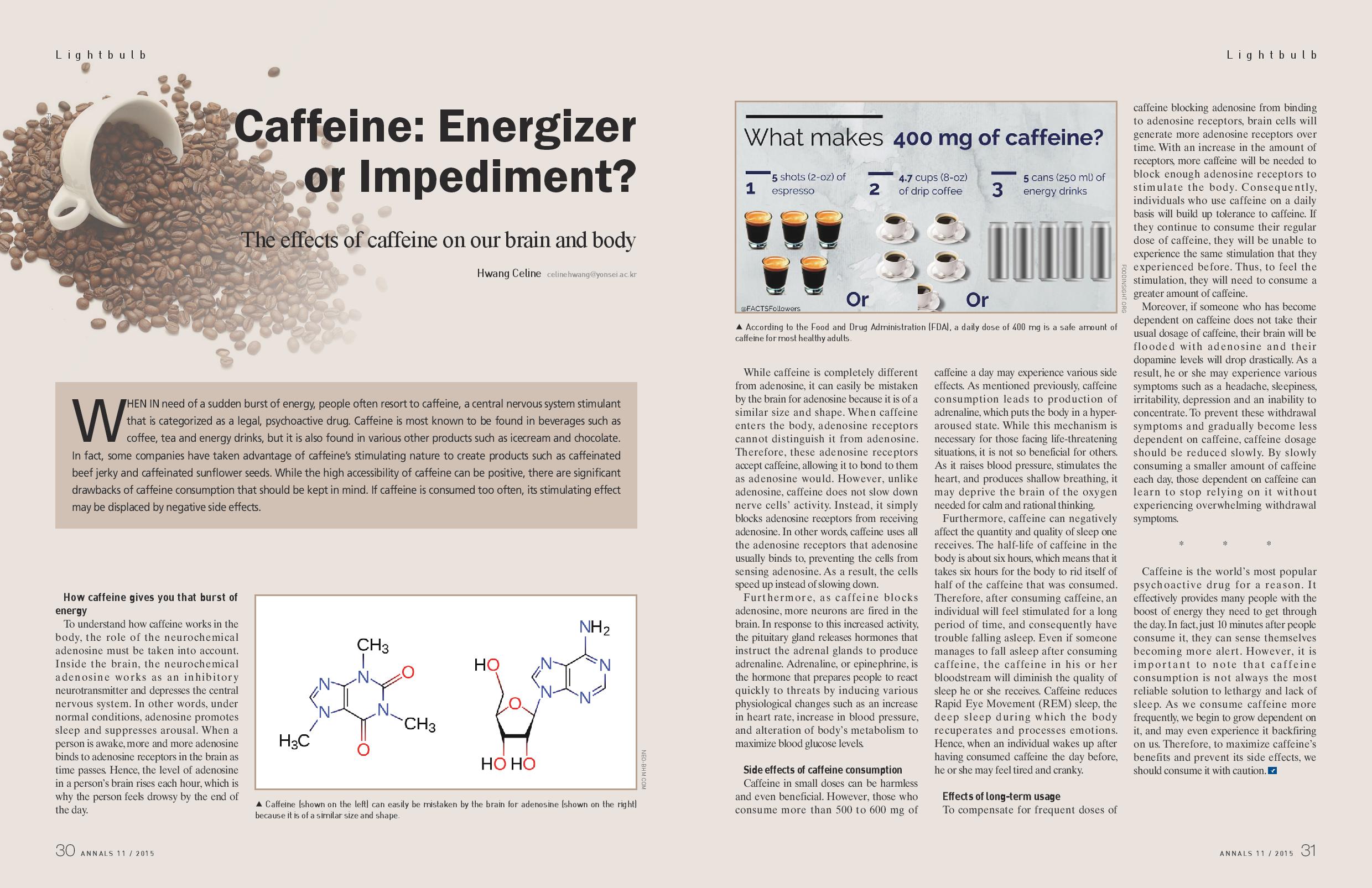The effects of caffeine on our brain and body


WHEN IN need of a sudden burst of energy, people often resort to caffeine, a central nervous system stimulant that is categorized as a legal, psychoactive drug. Caffeine is most known to be found in beverages such as coffee, tea and energy drinks, but it is also found in various other products such as icecream and chocolate. In fact, some companies have taken advantage of caffeine’s stimulating nature to create products such as caffeinated beef jerky and caffeinated sunflower seeds. While the high accessibility of caffeine can be positive, there are significant drawbacks of caffeine consumption that should be kept in mind. If caffeine is consumed too often, its stimulating effect may be displaced by negative side effects.
How caffeine gives you that burst of energy
To understand how caffeine works in the body, the role of the neurochemical adenosine must be taken into account. Inside the brain, the neurochemical adenosine works as an inhibitory neurotransmitter and depresses the central nervous system. In other words, under normal conditions, adenosine promotes sleep and suppresses arousal. When a person is awake, more and more adenosine binds to adenosine receptors in the brain as time passes. Hence, the level of adenosine in a person’s brain rises each hour, which is why the person feels drowsy by the end of the day.
While caffeine is completely different from adenosine, it can easily be mistaken by the brain for adenosine because it is of a similar size and shape. When caffeine enters the body, adenosine receptors cannot distinguish it from adenosine. Therefore, these adenosine receptors accept caffeine, allowing it to bond to them as adenosine would. However, unlike adenosine, caffeine does not slow down nerve cells’ activity. Instead, it simply blocks adenosine receptors from receiving adenosine. In other words, caffeine uses all the adenosine receptors that adenosine usually binds to, preventing the cells from sensing adenosine. As a result, the cells speed up instead of slowing down.
Furthermore, as caffeine blocks adenosine, more neurons are fired in the brain. In response to this increased activity, the pituitary gland releases hormones that instruct the adrenal glands to produce adrenaline. Adrenaline, or epinephrine, is the hormone that prepares people to react quickly to threats by inducing various physiological changes such as an increase in heart rate, increase in blood pressure, and alteration of body’s metabolism to maximize blood glucose levels.
Side effects of caffeine consumption
Caffeine in small doses can be harmless and even beneficial. However, those who consume more than 500 to 600 mg of caffeine a day may experience various side effects. As mentioned previously, caffeine consumption leads to production of adrenaline, which puts the body in a hyper-aroused state. While this mechanism is necessary for those facing life-threatening situations, it is not so beneficial for others. As it raises blood pressure, stimulates the heart, and produces shallow breathing, it may deprive the brain of the oxygen needed for calm and rational thinking.
Furthermore, caffeine can negatively affect the quantity and quality of sleep one receives. The half-life of caffeine in the body is about six hours, which means that it takes six hours for the body to rid itself of half of the caffeine that was consumed. Therefore, after consuming caffeine, an individual will feel stimulated for a long period of time, and consequently have trouble falling asleep. Even if someone manages to fall asleep after consuming caffeine, the caffeine in his or her bloodstream will diminish the quality of sleep he or she receives. Caffeine reduces Rapid Eye Movement (REM) sleep, the deep sleep during which the body recuperates and processes emotions. Hence, when an individual wakes up after having consumed caffeine the day before, he or she may feel tired and cranky.
Effects of long-term usage
To compensate for frequent doses of caffeine blocking adenosine from binding to adenosine receptors, brain cells will generate more adenosine receptors over time. With an increase in the amount of receptors, more caffeine will be needed to block enough adenosine receptors to stimulate the body. Consequently, individuals who use caffeine on a daily basis will build up tolerance to caffeine. If they continue to consume their regular dose of caffeine, they will be unable to experience the same stimulation that they experienced before. Thus, to feel the stimulation, they will need to consume a greater amount of caffeine.
Moreover, if someone who has become dependent on caffeine does not take their usual dosage of caffeine, their brain will be flooded with adenosine and their dopamine levels will drop drastically. As a result, he or she may experience various symptoms such as a headache, sleepiness, irritability, depression and an inability to concentrate. To prevent these withdrawal symptoms and gradually become less dependent on caffeine, caffeine dosage should be reduced slowly. By slowly consuming a smaller amount of caffeine each day, those dependent on caffeine can learn to stop relying on it without experiencing overwhelming withdrawal symptoms.
* * *
Caffeine is the world’s most popular psychoactive drug for a reason. It effectively provides many people with the boost of energy they need to get through the day. In fact, just 10 minutes after people consume it, they can sense themselves becoming more alert. However, it is important to note that caffeine consumption is not always the most reliable solution to lethargy and lack of sleep. As we consume caffeine more frequently, we begin to grow dependent on it, and may even experience it backfiring on us. Therefore, to maximize caffeine’s benefits and prevent its side effects, we should consume it with caution.
Hwang Celine
celinehwang@yonsei.ac.kr

